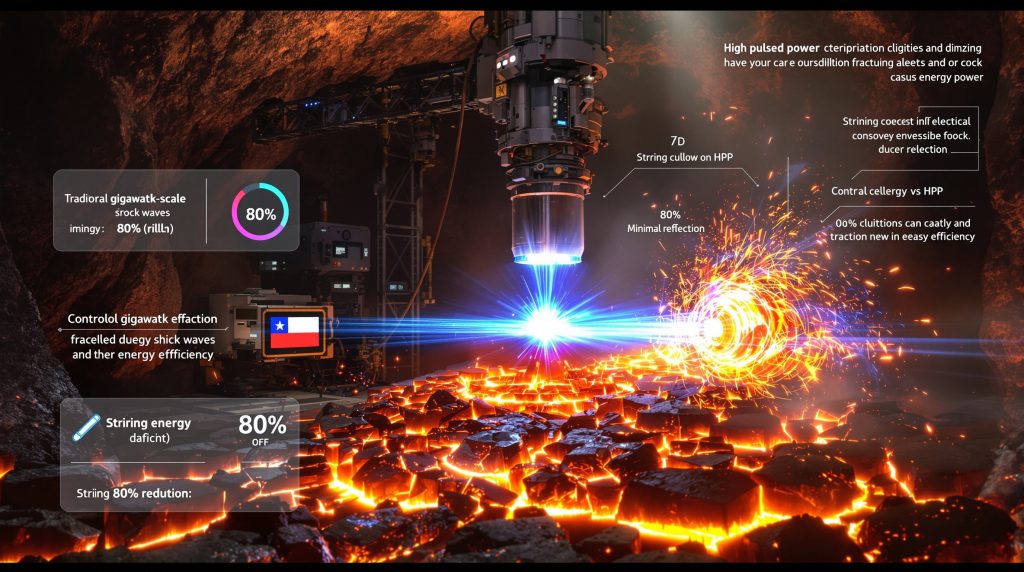Revolutionary Drilling Technologies: How Codelco's Investment in I-Pulse is Transforming Mining Operations
High-Pulsed Power (HPP) technology represents a breakthrough in mining operations, fundamentally changing how minerals are accessed and extracted. This innovative approach uses controlled electrical energy to generate powerful discharges that create gigawatt-scale shock waves, breaking rock formations from within rather than relying on traditional compressive force methods.
The mining industry is witnessing a technological revolution with HPP technology at its forefront, offering substantial advantages over conventional extraction methods. Energy consumption can be reduced by up to 80% during intensive extraction phases, while eliminating the need for traditional chemical explosives. The precision cutting and drilling capabilities enhance rock fragmentation efficiency with a significantly lower environmental footprint.
Instead of brute force approaches, HPP technology delivers concentrated electrical bursts that create internal fractures in rock formations. This allows for more precise mineral extraction compared to conventional methods that primarily rely on compressive force.
How is Codelco Leveraging Advanced Drilling Technologies?
Codelco, Chile's state-owned mining giant, has made a strategic move by acquiring a minority stake in I-Pulse to access cutting-edge drilling and fragmentation technologies. This investment, finalized in October 2025, builds upon a letter of intent signed in May 2025, formalizing a partnership focused on integrating pulsed energy technologies throughout Codelco's operations.
The partnership aims to implement advanced rock fragmentation systems across Codelco's mining portfolio while enhancing precision cutting and drilling processes. Key objectives include developing continuous underground mining methodologies, reducing energy consumption in extraction operations, and minimizing the environmental impacts of copper production.
By combining Codelco's extensive mining expertise with I-Pulse's technological innovations, the Codelco partnership insight seeks to create more efficient and environmentally responsible mining operations that can address the growing global demand for copper and other critical minerals essential for technological advancement and energy transition.
Who Are the Major Players Investing in Mining Technology Innovation?
Codelco joins an impressive roster of global mining leaders who have recognized the transformative potential of I-Pulse's technologies. This convergence of industry giants behind pulsed power technology signals a sector-wide acknowledgment that traditional mining methods cannot meet future mineral demands.
The collective investment demonstrates confidence in HPP as a game-changing approach that could revolutionize mineral extraction. The technology's potential impact has been compared to how dynamite transformed mining operations in the 19th century, representing a similar leap forward in extraction capability and efficiency.
| Mining Company | Strategic Interest |
|---|---|
| BHP | Rock fragmentation efficiency |
| Rio Tinto | Continuous mining systems |
| Newmont | Precision drilling applications |
| Ivanhoe Mines | Underground mining solutions |
| Teck Resources | Energy reduction technologies |
| Codelco | Integrated mining technologies |
This impressive lineup of major mining corporations backing I-Pulse's technology demonstrates the industry's collective shift toward more efficient, sustainable extraction methods to meet growing global mineral demands.
What Technical Challenges Does HPP Technology Address?
Energy Consumption Reduction
Traditional rock crushing and grinding processes consume enormous amounts of energy, representing up to 40% of a mine's total energy usage. HPP technology directly targets this inefficiency by reducing energy requirements by up to 80% during intensive extraction phases.
The technology minimizes the need for energy-intensive crushing and grinding circuits, potentially rendering conventional ball and semi-autogenous grinding (SAG) mill circuits obsolete in future mining operations. By enabling more precise application of energy directly to target areas, HPP technology addresses one of mining's most significant operational costs.
Precision Rock Fragmentation
The I-ROX division of I-Pulse has developed proprietary technology that leverages gigawatt-scale shock waves to fracture rock formations. This innovative approach utilizes tensile forces that break rock from the inside out, fundamentally changing how minerals are separated from surrounding material.
The targeted application minimizes waste and improves recovery rates, while controlled fragmentation enhances downstream processing efficiency. This precision allows mining operations to extract more value from existing resources with less energy and material waste.
Advanced Drilling Capabilities
The G-Pulse drilling technology offers revolutionary approaches to penetrating hard rock formations that have traditionally presented significant challenges for conventional drilling methods:
- Uses HPP to soften granite before drilling, reducing mechanical stress on equipment
- Enables access to previously uneconomical geothermal resources
- Reduces drill bit wear and tear, extending equipment lifespan
- Increases drilling speed in hard rock environments
- Minimizes vibration damage to surrounding formations
These capabilities open new possibilities for accessing difficult mineral deposits and could potentially unlock resources previously considered too challenging or expensive to extract.
What Environmental Benefits Does This Technology Offer?
The environmental advantages of implementing HPP technology extend well beyond energy reduction, addressing multiple sustainability challenges faced by the mining industry:
- Elimination of chemical explosives reduces toxic residues in mining areas
- Lower dust generation during extraction improves air quality
- Reduced water consumption in processing conserves local resources
- Smaller physical footprint for mining operations minimizes habitat disruption
- Decreased carbon emissions from reduced energy consumption
These benefits align with global sustainability goals and mining companies' increasing focus on environmental stewardship. By addressing concerns about mining's ecological impact while meeting growing demand for critical minerals, HPP technology offers a pathway toward more sustainable mining transformation.
The mining industry faces increasing pressure to reduce its environmental footprint while supplying the materials needed for the global energy transition. HPP technology represents a significant step toward resolving this apparent contradiction.
How Will This Technology Impact Copper Production?
Copper remains essential to global electrification efforts, renewable energy infrastructure, and digital technologies. The I-Pulse technology portfolio offers several potential impacts on copper production that could help meet growing global demand.
Production Efficiency
HPP technology enables more complete extraction from existing ore bodies, reducing processing costs through improved fragmentation. The resulting higher recovery rates from complex ores could extend mine life through more efficient extraction, allowing mining companies to derive more value from their existing assets.
As copper grades decline globally, the ability to efficiently process lower-grade ores becomes increasingly critical to maintaining supply. HPP technology addresses this challenge by making previously marginal resources economically viable.
Mining Economics
The economic benefits of HPP technology include lower operational costs through energy savings and reduced capital expenditure on traditional crushing equipment. This improves project economics for lower-grade deposits that might otherwise remain undeveloped.
The technology could enhance competitiveness in tight copper markets by reducing production costs and improving operational flexibility. As the copper industry faces increasing cost pressures, these efficiency gains could prove decisive for maintaining profitable operations.
Supply Chain Resilience
HPP technology offers the ability to process previously uneconomical resources, enabling more rapid development of new copper sources. The resulting enhanced flexibility in responding to market demands could reduce production disruptions through continuous mining techniques.
These capabilities could help address growing concerns about copper supply security amid increasing geopolitical tensions and resource nationalism. By expanding the economically viable resource base, HPP technology could help mitigate future supply constraints.
What is I-Pulse's Integrated Mining Vision?
I-Pulse is developing a comprehensive mining ecosystem through its I-Mine division, which integrates multiple technological innovations to transform how minerals are extracted and processed.
The company's vision involves merging I-ROX fragmentation and G-Pulse drilling technologies to facilitate continuous underground mining and processing. By eliminating reliance on chemical explosives and creating seamless extraction-to-processing workflows, I-Pulse aims to fundamentally change mining operations.
The development of digital twins for optimized operations represents another key aspect of the integrated approach. These digital models allow for simulation and optimization of mining processes before physical implementation, reducing risk and improving efficiency.
This integrated approach aims to transform mining from a series of discrete, energy-intensive steps into a continuous, efficient process that minimizes environmental impact while maximizing resource recovery. The vision represents a fundamental rethinking of mining operations rather than merely incremental improvements to existing methods.
How Does This Partnership Address Mining's Future Challenges?
The Codelco-I-Pulse partnership directly addresses several critical challenges facing the mining industry that will define its future viability and social license to operate.
Declining Ore Grades
As easily accessible, high-grade copper deposits become scarce, mining companies must process larger volumes of lower-grade ore to maintain production levels. This challenge intensifies energy consumption and environmental impacts under traditional mining approaches.
HPP technology enables more efficient extraction from lower-grade resources, reducing energy costs for processing larger volumes. The improved economics for previously marginal deposits could help maintain copper production despite the industry-wide decline in ore grades.
Energy Transition Demands
The global shift toward renewable energy and electrification requires unprecedented quantities of copper and other critical minerals. Current mining methods struggle to meet projected demand increases without significant environmental consequences.
HPP technology could unlock significant production capacity while reducing competition for energy resources. This efficiency gain is particularly important as mining operations increasingly compete with other sectors for clean energy access.
Environmental Pressures
Increasing regulatory and social pressures demand more sustainable mining practices, challenging the industry's traditional operating methods:
- HPP technology significantly reduces environmental footprint across multiple metrics
- Lower emissions align with global climate goals and corporate commitments
- Reduced waste generation improves community relations and social license to operate
By addressing these environmental concerns, HPP technology could help mining companies maintain access to resources in regions with increasingly stringent environmental regulations.
What is the Implementation Timeline for These Technologies?
While specific timelines haven't been publicly disclosed for Codelco's implementation of I-Pulse technologies, technology deployment in mining typically follows a phased approach to manage risk and validate performance:
-
Initial Testing Phase: Laboratory-scale validation of technology applications in Codelco's specific geological contexts, typically lasting 6-12 months
-
Pilot Implementation: Deployment at selected Codelco operations to validate performance in real-world conditions, usually involving a single site or production line over 1-2 years
-
Scaled Deployment: Broader implementation across multiple mining operations following successful pilot results, typically phased over 2-3 years
-
Full Integration: Comprehensive adoption throughout Codelco's production chain, potentially taking 3-5 years from initial testing to complete integration
Each phase includes rigorous evaluation of performance metrics, economic benefits, and operational improvements to ensure the technology delivers its promised advantages before advancing to wider deployment. This measured approach helps manage investment risk while allowing for adaptation to site-specific conditions.
What Are the Implications for the Global Mining Industry?
The Codelco-I-Pulse partnership signals a fundamental shift in how mining companies approach resource extraction, with far-reaching implications for the entire industry ecosystem.
Industry-Wide Technology Adoption
Major miners' investments validate HPP technology's potential, creating competitive pressure for broader industry adoption. This momentum accelerates development of complementary technologies and establishes new benchmarks for operational efficiency that could reshape industry standards.
As early adopters gain competitive advantages through reduced costs and improved environmental performance, other mining companies will face increasing pressure to follow suit or risk being left behind. This dynamic could accelerate the pace of mining innovation trends across the sector.
Mining Equipment Evolution
Traditional equipment manufacturers must adapt or risk obsolescence as HPP technology changes fundamental mining processes. This disruption creates new opportunities for specialized technology providers while potentially disrupting established supply chains.
The integration challenges with existing infrastructure will require creative solutions and could drive further innovation in system integration and mining equipment design. Equipment manufacturers who recognize and adapt to this shift early will have significant advantages.
Skills and Workforce Transformation
The shift to HPP technology will require new technical competencies for advanced technology operation, moving mining operations from labor-intensive to technology-intensive processes. This transition offers enhanced safety through reduced exposure to hazardous conditions.
The emergence of opportunities for higher-skilled mining roles could help address the industry's ongoing challenges with talent attraction and retention. However, it also necessitates significant investment in workforce development and training programs to ensure workers can effectively operate and maintain these advanced systems.
FAQ: Codelco's Investment in Advanced Drilling Technology
How does HPP technology compare to conventional drilling methods?
HPP technology fundamentally differs from conventional drilling by using electrical discharges to weaken rock structures before mechanical penetration. This pre-conditioning process results in faster drilling rates, reduced equipment wear, and lower energy consumption compared to traditional rotary or percussion drilling methods that rely solely on mechanical force.
Conventional methods typically achieve penetration rates of 5-15 meters per hour in hard rock, while preliminary tests of AI-driven drilling innovations combined with HPP-assisted drilling have shown potential improvements of 30-50% in similar conditions. The reduction in mechanical stress also extends drill bit life by up to 300% in certain applications.
What specific copper projects will benefit first from this technology?
While Codelco hasn't announced specific implementation sites, the technology is likely to be deployed first at operations facing challenges with hard rock formations, high energy costs, or environmental constraints. Based on these criteria, potential early adoption sites might include:
- Underground operations with high rock hardness that challenge conventional drilling
- Projects located in areas with limited water resources where traditional processing is constrained
- Operations with declining ore grades requiring more efficient extraction methods
- Mines with stringent environmental compliance requirements or community concerns
The technology offers particular advantages for hard-to-access deep deposits where traditional methods face significant technical challenges and escalating costs.
How will this technology affect Codelco's production costs?
Industry analysts project that full implementation could reduce energy costs by up to 80% during intensive extraction phases, potentially lowering overall production costs by 15-30% depending on site-specific factors and implementation scale.
The most significant savings would likely come from:
- Reduced energy consumption during rock breaking and fragmentation
- Lower maintenance costs due to decreased wear on mechanical components
- Improved throughput and recovery rates enhancing production efficiency
- Reduced consumption of grinding media and other consumables
- Potential elimination of certain processing stages through improved fragmentation
These cost reductions could significantly improve Codelco's competitive position in global copper markets, especially important as the company manages rising production costs at some of its aging operations.
What are the limitations of pulsed power technology in mining?
Current limitations include scale-up challenges for very large operations and integration with existing infrastructure. The technology requires specialized maintenance capabilities and reliable high-power electrical supplies at remote mining locations.
Additional constraints include:
- Initial capital investment requirements for implementation
- Need for site-specific customization based on geological conditions
- Training requirements for technical personnel
- Limited commercial-scale deployment history in mining applications
- Regulatory approvals for novel extraction technologies
These limitations will likely be addressed through the phased implementation approach, allowing for technological refinement and adaptation to specific operational conditions before full-scale deployment.
Transforming Mining Through Technological Innovation
Codelco's investment in I-Pulse represents a strategic commitment to transforming copper mining through technological innovation. By leveraging advanced pulsed power technologies for drilling, fragmentation, and continuous mining, Codelco positions itself at the forefront of a mining revolution that promises greater efficiency, lower environmental impact, and enhanced ability to meet growing global demand for critical minerals.
The partnership exemplifies how traditional mining giants are embracing disruptive technologies to address the industry's most pressing challenges. As Codelco board chairman Máximo Pacheco noted, "Innovation is key to the future of mining, and at Codelco, we face significant technical challenges that are at the forefront of human knowledge."
This technological transformation comes at a crucial time, as the mining industry must dramatically increase production of copper and other critical minerals to support global electrification, renewable energy deployment, and digital infrastructure development. By pioneering advanced drilling and fragmentation technologies, Codelco is not only securing its own future but potentially reshaping how the entire mining industry approaches resource extraction.
The significance of this partnership extends beyond immediate operational improvements to address fundamental sustainability challenges facing the mining sector. As society demands both more minerals for technological advancement and better environmental stewardship, innovations like HPP technology offer a pathway to reconcile these seemingly contradictory requirements.
For investors, suppliers, and other stakeholders in the mining industry, Codelco's move signals the acceleration of a technological transformation that could redefine competitive advantages and reshape industry economics. Companies that recognize and adapt to this shift early may find significant opportunities, while those that remain committed to traditional approaches may face increasing competitive challenges as data-driven mining operations become the new standard.
Ready to Stay Ahead of Mining Technology Trends?
Discover how major mineral discoveries and technology breakthroughs can create substantial investment returns by exploring Discovery Alert's proprietary Discovery IQ model, which delivers real-time alerts on significant ASX mining announcements and opportunities. Visit our discoveries page today to gain a market-leading edge on emerging mining technologies and resource opportunities.




